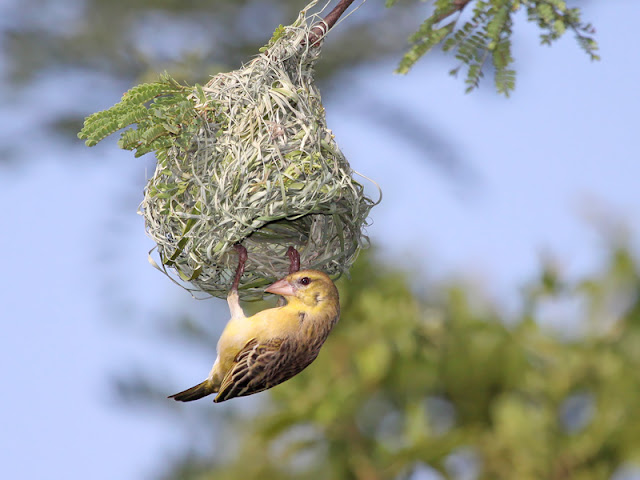I was a bit undecided as to where to go birding on Sunday. Mkhombo Dam had a lot of specials going for it but it was a bit far for a 05h00 start, so I decided on Bishop Bird Park which is within 5 minutes travel from our house. This small park has produced some real specials in the past and is always worth a visit.
 |
| The parks namesake - Southern Red Bishop |
 |
| Immature Little Sparrowhawk |
This reserve seems to be a training ground for Southern Masked Weavers as there are several young birds scattered around the park practising their nest building skills. These birds are not yet full adults and do not sport the typical breeding plumage of the adult males but they are all hard at work building nests which range from misshapen balls of grass to fairly decent, albeit odd shaped, weaver nests.
 |
| Immature Southern Masked Weaver - apprentice nest builder |
One of my favourite local birds the Cape Glossy Starling, is also common in the reserve. I just love the way their feathers shine in the sunlight which is not that easy to capture in a photograph
 |
| Cape Glossy Starling |
An interesting bird for the park and one that I have never seen there before was a single African Olive Pigeon. I have seen flocks of them in the surrounding suburb before but never here at Bishop Bird Park.
 |
| African Olive Pigeon |
I also noticed that the summer migrants seem to be back in numbers. I had good views of Spotted Flycatcher and a female Dideriks Cuckoo. Willow Warblers are common at the moment and I found them in almost every bush, photographing them however is not for the stressed individual.
 |
Spotted Flycatcher
Male Diederiks Cuckoo
|
 |
| Willow Warbler |
Other migrants to the park were the Brownveined White butterflies who undertake a local migration at this time of year and can be seen in large numbers around the Gauteng area. Here they were taking advantage of the numerous blossoms adorning the Acacia Karoo trees in the Park.
 |
| Brownveined White |
My last bird for the morning was the ubiquitous White-bellied Sunbird that are commonly heard calling from the tops of the trees around the area in summer. They are also one of the more brightly coloured birds found in the park.
 |
| Male White-bellied Sunbird |
All in all I ticked a total of 44 species in two hours birding in this small bird park which is situated in the middle of a plethora of townhouses and security housing complexes. Next time I hope to report on my trip to Mkhombo Dam which has some real specials at present in the form of Pygmy Goose, Pectoral Sandpiper and Ruddy Turnstone.....Cheers G..



































